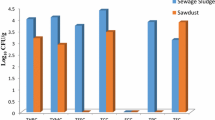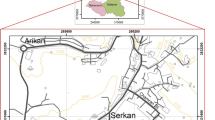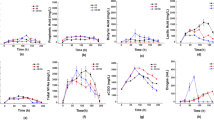Abstract
The composition of the most abundant facultative anaerobic bacteria populations [faecal coliforms (FC) and enterococci (ENT)] in sludge can be modified after different treatments. These involve the disposal or reuse of sludge and include: anaerobic digesters, incineration, composting, pasteurization and lime treatments. In this study, three treatment types (mesophilic anaerobic digestion, composting and pasteurization) were compared in terms of their ability to reduce both bacterial populations. The diversity and any changes in composition of main phenotypic groups for both populations were also analyzed. Mesophilic anaerobic digestion (MAD) was carried out at 35°C for 20 days. Digested sludge was then dehydrated by centrifugation at 2,500 rpm. Composting (COM) was performed at 55°C with windrow phases. Pasteurization was assayed at 60°C for 90 min (P60), at 80°C for 60 min (P80). A 1–1.5 log unit reduction was observed for FC, and 1 log unit reduction was noted for ENT by MAD treatment. In composting, this reduction proved higher for FC than for ENT (6 log and 3–4 log units, respectively). Optimal pasteurization was obtained at 80°C for 60 min, resulting in a 5 log unit reduction for FC and a 2 log unit reduction for ENT. High diversity indices (Di) for both bacterial populations were detected both before and after implementation of the different treatments. Analyses of the population’s similarity provided that FC were diverse both before and after COM, P60 and P80 treatments. However, no differences were observed on the composition of ENT populations after the different treatments assayed.

Similar content being viewed by others
References
Anon (1994) Guidance on the preservation and handling of samples ISO 5667/3
Becrg G, Berman D (1980) Destruction by anaerobic mesophilic and thermophilic digestion of viruses and indicator bacteria indigenous to domestic sludges. Appl Environ Microbiol 39:361–368
Bianchi MAG, Bianchi AJM (1982) Statistical sampling of bacterial strains and its use in bacterial diversity measurement. Microb Ecol 8:61–69
Biton G (1994) Activated sludge process. In: Mitchell R (ed) Wasterwater microbiology. Wiley-Liss, New York, pp 147–166
Blanch AR, Caplin JL, Iversen A, Kuhn I, Manero A, Taylor HD, Vilanova X (2003) Comparison of enterococcal populations related to urban and hospital wastewater in various climatic and geographic European regions. J Appl Microbiol 94:994–1002
Carrington EG, Harman SA, Pike EB (1982) Inactivation of Salmonella during anaerobic digestion of sewage sludge. J Appl Bacteriol 53:331–334
Edmonds RL (1976) Survival of coliform bacteria in sewage sludge applied to a forest clearcut and potential movement into groundwater. Appl Environ Microbiol 32:537–546
Figueras MJ, Inza FP, Guarro J (1998) Evaluation of the oxolinic acid-esculin-azide medium for isolation and enumeration of fecal streptococci in a routine monitoring program for bathing waters. Can J Microbiol 44:998–1002
Fukushi K, Babel S, Burakrai S (2003) Survival of Salmonella spp in a simulated acid-phase anaerobic digester treating sewage sludge. Bioresour Technol 87:177–181
Gavala HN, Yenal U, Skiadas IV, Westermann P, Ahring BK (2003) Mesophilic and thermophilic anaerobic digestion of primary and secondary sludge effect of pre-treatment at elevated temperature. Water Res 19:4561–4572
Gibbs RA, Hu CJ, Ho GE, Unkovich I (1997) Regrowth of faecal coliforms and Salmonella in stored biosolids and soil amended with biosolids. Water ScienTechnol 35:269–275
González JM, Iriberri J, Egea L, Barcina I (1990) Differential rates of digestion of bacteria by freshwater and marine phagotrophic protozoa. Appl Environ Microbiol 56:1851–1857
Grabow WOK (1998) Microbiology of drinking water treatment; reclaimed wastewater. In: Drinking water microbiology progress and recent developments. Springer, New York, pp 259–264
Herbst B (2000) Sewage sludge treatment with lime. Schriftenr Ver Wasser Boden Lufthyg 105:337–340
Horan NJ, Fletcher L, Betmal SM, Wilks SA, Keevil CW (2004) Die-off of enteric bacterial pathogens during mesophilic anaerobic digestion. Water Res 38:1113–1120
Kuhn I (1985) Biochemical fingerprinting of Escherichia coli: a simple method for epidemiological investigations. J Microbiol Methods 3:159–170
Kuhn I, Allestam G, Huys G, Janssen P, Kersters K, Krovacek K, Stenstrom T (1997) Diversity, persistence, and virulence of Aeromonas strains isolated from drinking water distribution systems in Sweden. Appl Environ Microbiol 63:2708–2715
Kuhn I, Allestam G, Stenström AT, Möllby R (1991) Biochemical fingerprinting of water coliform bacteria, a new method for measuring phenotypic diversity and for comparing different bacterial populations. Appl Environ Microbiol 57:3171–3177
Kuhn I, Iversen A, Burman LG, Olsson-Liljequist B, Franklin A, Finn M, Aarestrup F, Seyfarth AM, Blanch AR, Taylor H, Caplin J, Moreno MA, Dominguez L, Mollby R (2000) Epidemiology and ecology of enterococci, with special reference to antibiotic resistant strains, in animals, humans and the environment example of an ongoing project within the European research programme. Int J Antimicrob Agents 14:337–342
Kuhn I, Mollby R (1992) The PhP RS system a simple microplate method for studying coliform bacterial populations. J Microbiol Methods 17:255–259
Lasobras J, Dellunde J, Jofre J, Lucena F (1999) Occurrence and levels of phages proposed as surrogate indicators of enteric viruses in different types of sludges. J Appl Bacteriol 86:723–729
Manero A, Blanch AR (1999) Identification of Enterococcus spp with a biochemical key. Appl Environ Microbiol 65:4425–4430
Moce-Llivina L, Muniesa M, Pimenta-Vale H, Lucena F, Jofre J (2003) Survival of bacterial indicator species and bacteriophages after thermal treatment of sludge and sewage. Appl Environ Microbiol 69:1452–1456
Novinscaka AS, Filion M (2007) Quantification of Salmonella spp in composted biosolids using a TaqMan qPCR assay. J Microbiol Methods 11:119–26
Pourcher AM, Devriese LA, Hernadez JF, Delattre JM (1991) Enumeration by miniaturized method of Escherichia coli and streptococcus-bovis and enterococci as indicators of the origin of fecal pollution waters. J Appl Bacteriol 70:525–530
Salsali HR, Parker WJ, Sattar SA (2006) Impact of concentration, temperature, and pH on inactivation of Salmonella spp by volatile fatty acids in anaerobic digestion. Can J Microbiol 52:279–288
Scheuerman PR, Farrah SR, Biton G (1991) Laboratory studies of virus survival during aerobic and anaerobic digestion of sewage sludge. Water Res 3:241–245
Sinton LW, Finlay RK, Hannah DJ (1998) Distinguishing human from animal faecal contamination in water: A review. N Z J Mar Freshwater Res 32:323–348
Stenstrom TA, Carlander A (2001) Occurrence and die-off indicator organism in the sediment in two constructed wetlands. Water Scie Technol 38:223–230
Straub TM, Pepper IL, Gerba CP (1992) Persistence of Viruses in Desert Soils Amended with Anaerobically Digested Sewage Sludge. Appl Environ Microbiol 58:636–641
Vilanova X, Blanch AR (2005) Distribution and persistence of fecal bacterial populations in liquid and dewatered sludge from a biological treatment plant. J Gen Appl Microbiol 51:361–368
Vilanova X, Manero A, Cerda-Cuellar M, Blanch AR (2002) The effect of a sewage treatment plant effluent on the faecal coliforms and enterococci populations of the reception river waters. J Appl Microbiol 92:210–214
Vilanova X, Manero A, Cerda-Cuellar M, Blanch AR (2004) The composition and persistence of faecal coliforms and enterococcal populations in sewage treatment plants. J Appl Microbiol 96:279–288
Acknowledgments
This research was supported by project CGL2007-65980-C02-01/HID from the Ministerio de Educación y Ciencia and by project A102/2007/1.04.2 from the Ministerio de Medio Ambiente of the Spanish Government.
Author information
Authors and Affiliations
Corresponding author
Rights and permissions
About this article
Cite this article
Bonjoch, X., Blanch, A.R. Resistance of Faecal Coliforms and Enterococci Populations in Sludge and Biosolids to Different Hygienisation Treatments. Microb Ecol 57, 478–483 (2009). https://doi.org/10.1007/s00248-008-9430-7
Received:
Revised:
Accepted:
Published:
Issue Date:
DOI: https://doi.org/10.1007/s00248-008-9430-7




